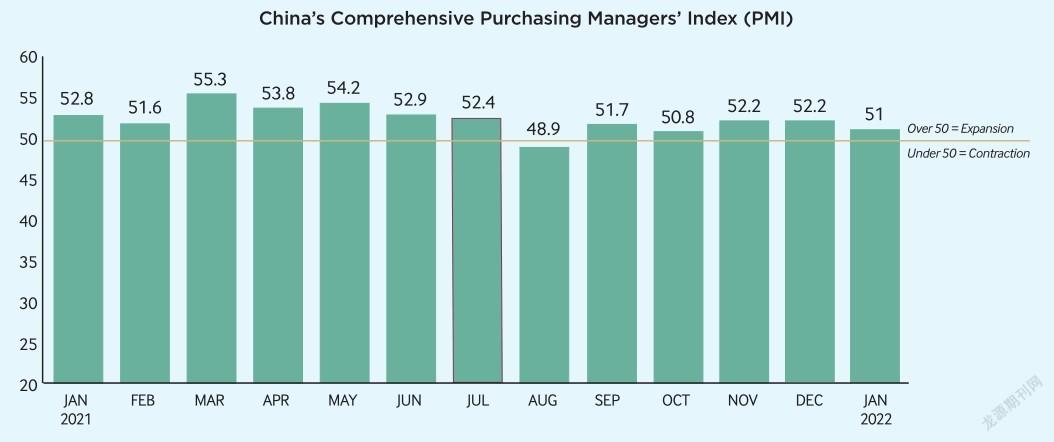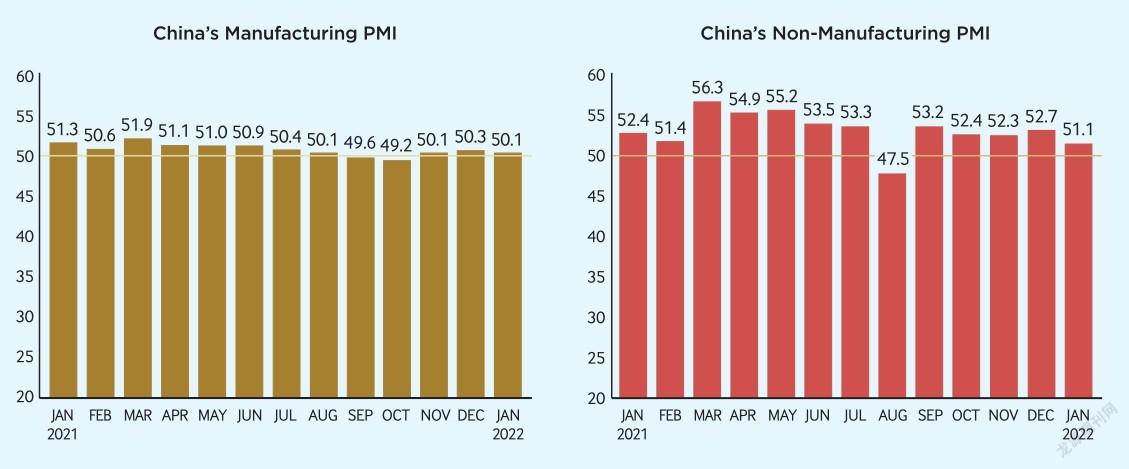A SPOT OF SPORTS
2022-02-26
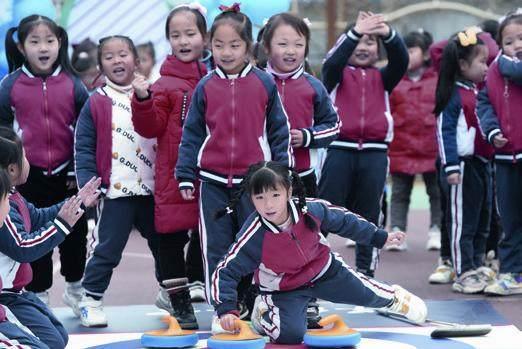
Children from a kindergarten in Hefei, capital of Anhui Province, take a try at floor curling on February 16. The kindergarten set up different games like floor curling and floor hockey on the first day of the new semester, giving the kids a chance to learn about the Olympic Winter Games and experience the joys of sports.
The Beijing 2022 Games have boosted public enthusiasm for winter sports. Many schools use the occasion to cultivate their students’ winter sports skills. In areas without ice and snow, activities like floor curling are becoming popular.
A farmer prunes a peach tree in a greenhouse in Weiqiao Village, Qingtongxia City of Ningxia Hui Autonomous Region, on February 15. The village, located in northwest China, has been developing fruit planting in recent years to promote rural tourism and increase farmers’ income.

With the completion of the branch line for the Olympic and Paralympic Winter Games Beijing 2022, the capital city’s rail-transit system had expanded to 27 lines by late 2021, running more than 10,000 trains and transporting nearly 10 million passengers every day, according to the Beijing Metro Network Control Center(BMNCC).
The data were shared with journalists from 36 domestic and overseas media outlets during a February 14 visit to the BMNCC, providing further insight into the Olympic host’s transportation network.
Beijing’s first subway line, also the first in China, started operating in 1969. Since then, Beijing has gone on to establish a safe, convenient, efficient and green rail-transit system.
Line 11, which opened in 2021 to provide transport to the different Winter Olympics venues, is a smart rail-transit demonstration line featuring intelligent operation and maintenance systems.
Trains on 10 metro lines run at a minimum interval of two minutes during peak hours.
Compared with traveling by car, Beijing’s rail-transit system reduces carbon emissions by 7.38 million tons per year, equivalent to the amount of carbon absorbed by 410 million trees, according to the BMNCC.
The Ministry of Emergency Management has launched a year-long campaign to ensure the elimination of related risks during the relocation of hazardous chemical industries in China, ministry sources said on February 15.
The move comes as the country has accelerated the relocation of hazardous industries to its central, western and northeastern regions from eastern coastal areas in recent years, Sun Guangyu, an official with the ministry, told a press conference.
The campaign will take place across 21 provincial regions involved in different moving projects, said Sun, adding more than 470 such undertakings are expected to roll out this year.
The sound management of safety risks is necessary to avoid accidents, Sun said.
The campaign seeks to strengthen the evaluation of new and existing projects and take action on those that fail to meet safety standards, Sun added.
A total of 632 hazardous chemicals-related projects have been relocated since 2019.
Chinese researchers have discovered a flower bud fossil, so far the world’s earliest, in Inner Mongolia Autonomous Region.
The fossil contains a stem, a leafy branch, a bulbous fruit, and a tiny flower bud, measuring around 3 square mm in size, according to Wang Xin, a researcher with the Nanjing Institute of Geology and paleontology under the Chinese Academy of Sciences in Jiangsu Province.
The flower bud is less than 4 mm long, shorter than a human fingernail, he said.
The fossil was found in Ningcheng County of Inner Mongolia. Scientists said the fossilized flower bud stems from the Jurassic period, about 160 million years ago, when dinosaurs still roamed the Earth.
The study has been published (online) in Geological Society London Special Publications journal.
China has built 869 warehouses for the centralized supervision of imported cold-chain foods, the country’s market regulator announced on February 14.
The warehouses will conduct unified disinfection and testing procedures for imported coldchain foods, which can enter the market only after being certified at the warehouses, according to the State Administration for Market Regulation.
These warehouses will play an important role in cutting off any potential COVID-19 transmission channels, facilitating the disposal of imported cold-chain foods in emergency cases and reducing costs, the administration further said.
A national platform to trace imported cold-chain foods went into operation in December 2020, involving key items such as livestock, poultry and aquatic products.
Farmers work the fields of Kangxiling Town in Qinzhou, Guangxi Zhuang Autonomous Region, on February 10.
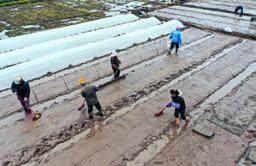
Tibet Autonomous Region has released an implementation plan with set targets for its fitness development between 2021 and 2025, Xinhua News Agency reported on February 14.
The local sports bureau plans to build or reconstruct no fewer than 34 sports parks and 95 national fitness centers.
According to the plan, people who often exercise are expected to account for 38.5 percent of Tibet’s population by 2025. Sports space per capita is scheduled to reach 2.6 square meters, with 2.16 social sports instructors for every 1,000 people by 2025.
The region aims to develop its specific fitness brand by continuing to stage activities such as the Tibet Mountaineering Conference and the Lhasa Half Marathon, expanding participation among local farmers and herdsmen.
Tibet also plans to encourage investment from all sectors in the construction of sports venues and related facilities.
The State Council has decided to conduct the third national soil condition census from 2022 to 2025, according to a circular released on February 16.
The census aims to analyze soil types and distribution around the country, as well as the current status and changing trends of soil resources, while acquiring basic data such as quality, properties and utilization status, to improve protection and utilization of soil resources.
The census on saline-alkali soil will be completed in 2022.
In the first half of 2025, the census data will be sorted and reviewed, and in the second half, a report on national arable land quality and an evaluation report on national soil utilization suitability will be prepared, according to the circular.
Tourists pose for a photo on a newly paved footpath at the former site of Chongqing Iron and Steel Factory in Chongqing Municipality, on February 15. The track is one of 60 of its kind planned by local authorities in the mountainous city for people to go exercise.
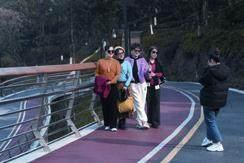
China aims to reduce the generated intensity of industrial solid waste in steel, nonferrous metals, and chemical sectors by 2025, all the while improving the utilization of bulk solid waste, Xinhua reported on February 10.
According to a plan jointly issued by the Ministry of Industry and Information Technology and seven other government bodies, China will see the allencompassing development of its renewable resource sector by 2025. Its utilization rate of bulk industrial solid waste is set to reach 57 percent, said the plan.
Measures include enhancing technological and industrial upgrades to reduce solid waste and promoting the standardized utilization of renewable resources such as scrap steel and plastics. Further actions include improving the recycling and application system of old power batteries.
Through strengthened legislation and supervision, China has achieved progress in preventing solid waste pollution.
The revised Law on the Prevention and Control of Environmental Pollution by Solid Waste first took effect on September 1, 2020.
The consumer price index (CPI), a main gauge of inflation, rose 0.9 percent year on year in January, down from the 1.5-percent increase a month ago, the National Bureau of Statistics said on February 16.
A breakdown showed that food prices dropped 3.8 percent, a decline of 2.6 percentage points higher than that in December 2021.
The price of pork, a staple meat in China, slumped 41.6 percent, compared with a 36.7-percent decrease a month ago.
Non-food prices rose 2 percent, eased from the 2.1-percent increase reported in the previous month.
The core CPI, which excludes food and energy prices, gained 1.2 percent, flat with a month ago.
The producer price index, which measures costs for goods at the factory gate, went up 9.1 percent in January.
Paid-in foreign direct investment(FDI) into the Chinese mainland expanded 11.6 percent year on year to 102.28 billion yuan($16.14 billion) in January, the Ministry of Commerce said on February 15.
In U.S. dollar terms, the inflow went up 17.6 percent.
Foreign investment in the service industry amounted to 82.3 billion yuan ($12.98 billion) last month, up 12.2 percent, while inflow to hi-tech industries surged 26.1 percent, the figures showed.
Investments from other Belt and Road Initiative participants and members of the Association of Southeast Asian Nations increased 28.4 percent and 29.1 percent, respectively.
With government policies aimed at stabilizing foreign trade and investments taking effect, China will continue to see notable foreign investment influx to hi-tech industries as well as the central and western regions, Liu Xiangdong, a researcher with the China Center for International Economic Exchanges, said.
China’s outstanding yuan funds for foreign exchange stood at nearly 21.3 trillion yuan ($3.35 trillion) by late January, up 33.34 billion yuan ($5.26 billion) from the previous month, according to the People’s Bank of China on February 15.
As the Chinese yuan is not freely convertible under the capital account, the central bank must purchase foreign currency generated by a trade surplus and foreign investment in the country, adding funds to the money market. These assets are an important indicator of crossborder foreign capital flow and domestic yuan liquidity.
China’s forex holdings came in at $3.2216 trillion in late January, down $28.5 billion, or 0.88 percent, from late 2021, data from the State Administration of Foreign Exchange showed.
China aims to establish a relatively complete modern forest and grass industry system by 2025, with total output value reaching 9 trillion yuan ($1.41 trillion), read a development plan.
The country also strives to establish itself as a leading force in the international trade of forest and grass products, with annual import and export volume hitting$195 billion by 2025, according to the outline for the 14th FiveYear Plan (2021-25) period, released by the National Forestry and Grassland Administration.
The document specified 12 key sub-sectors for development during the period, including economic forestry, wood processing and ecological tourism.
It also identified forest and grass planting areas to ensure that no arable land or permanent farmland is occupied.
China should cultivate and rationally utilize forest and grass resources, promote the deeper integration of industries, and increase the effective supply of quality forest and grass products, the plan further noted.
The securities regulator has unveiled revised provisions of the Stock Connect program between domestic and overseas stock exchanges to expand its scope.
Previously, only companies listed on the Shanghai and London stock exchanges could participate in Stock Connect. According to revisions released by the China Securities Regulatory Commission (CSRC) on February 11, eligible companies listed on the Shenzhen Stock Exchange will be included, along with stock exchanges in Switzerland and Germany.
The provisions, which already entered into force, introduce arrangements to allow overseas issuers to raise capital in the Chinese market through China Depositary Receipt (CDR) offerings and adopt a market-inquiry pricing mechanism.
Better and more flexible arrangements are in place for annual report disclosure requirements plus the disclosure of changes in shareholding, according to the provisions.
Considering the quota for eastbound and westbound business remains ample, the total cross-border capital quota for the existing interconnected depositary receipt business remains unchanged.
The quota for eastbound business (London-listed companies listing CDRs on the Shanghai Stock Exchange’s main board) stays at 250 billion yuan ($39.26 billion), while that for westbound (Shanghai-listed companies listing global depositary receipts on the London Stock Exchange’s main board) continues at 300 billion yuan($47.34 billion).
Adjustments will be made in terms of business situations and market demands, the CSRC said.
The total assets of Chinese insurers amounted to 24.9 trillion yuan ($3.91 trillion) by last December, up 11.5 percent from the beginning of 2021, the China Banking and Insurance Regulatory Commission said.
Specifically, the total assets of property insurance companies, life insurance companies and reinsurance companies went up 6 percent, 12.4 percent and 22.2 percent, respectively.
Last year, insurers’ premium income increased 4.1 percent year on year to 4.5 trillion yuan($710 billion).
The comprehensive solvency adequacy ratio of insurers, a key metric to measure their ability to meet debts and other obligations, stood at 240 percent at the end of last September. The average core solvency ratio was 227.3 percent, data showed.
China reported a current account surplus of $315.7 billion in 2021, accounting for 1.8 percent of its GDP for the year, Wang Chunying, a spokesperson for the State Administration of Foreign Exchange, said on February 11.
Trade in goods posted a surplus of $554.5 billion, up 8 percent from the previous year.
Trade in services saw a deficit of $97.7 billion, down 33 percent year on year. The deficit in the travel sector declined 15 percent to $99.3 billion due to the COVID-19 pandemic’s continued impact on cross-border tourism and studies abroad, Wang said.
She projected that China’s international payments, despite external instabilities and uncertainties, will remain generally balanced.
($1=6.33 yuan)
